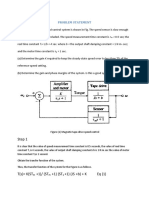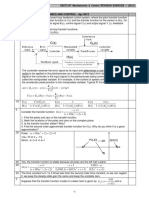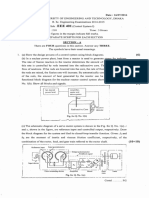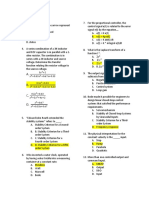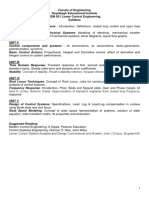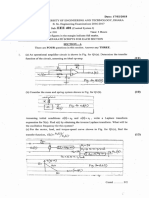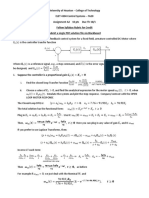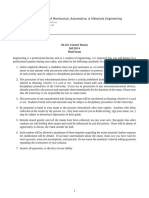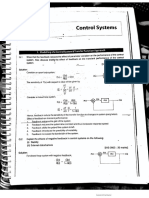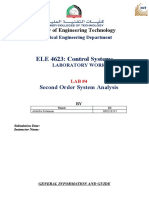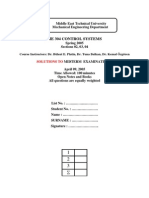0 ratings0% found this document useful (0 votes)
61 views62 pagesTime Domain Analysis
Uploaded by
Daredevil GamerCopyright
© © All Rights Reserved
We take content rights seriously. If you suspect this is your content, claim it here.
Available Formats
Download as PDF or read online on Scribd
0 ratings0% found this document useful (0 votes)
61 views62 pagesTime Domain Analysis
Uploaded by
Daredevil GamerCopyright
© © All Rights Reserved
We take content rights seriously. If you suspect this is your content, claim it here.
Available Formats
Download as PDF or read online on Scribd
You are on page 1/ 62
ser
functions
(a)
(b)
Solution
(a)
Problem 4.1 Find the time response, initi:
AY s(s +10)
(s+2)(s+4)(s +6)
125+)
Fs) =
(9) = aaa) eee
Fis) = — GH Oa
(8+ 2)(5+4)(s+ 6)
S(t) =e + 664
Initial value = Him gy) =
Final value = lim
Fo) = —2G+y
99+ 2)?(943)
Domain Analysis
Time
10(s +1)
5 2
= Transfer function = Xs) = S (542) a 10(s+1),
; “ a Sst2) 7) Ans
Problem 4.3 A servo system for the position cont js e
py viscous friction damping which ist three-qua eee stabilised
damping. The undamped natural frequency of the sy are pin Ree critical
expression for the output of the system, if the input control is sudd ive an
anew position, being initially at rest. Hence, find the maximum 1 ces
Solution
The output response is given by
a PB en at
y(t) = G) 1— sin(@,t + @)
(22
Now &= 0.75 (given)
1-@ — 0757
= ene NiOrsa aye
$ 0.75
But 41.419 = 09
180.
Q,= o,\1-2
=2ax 12 =75.4 rad/s
@, = 12 Hz = 12 cycles/sec.
= 75.41 07% =50
J
Problems
my’ and the sti 5
ate the viscous frictional torque required to produce critical,
critical damping, calculate the amplitude of swing of flywh
between the flywheel and the control lever.
Solution etal
K(O,- &) = Us" + Fs)
for critical damping
F=2VJK =2,/150 x 2400 = 1200N
We know that
-. Torque equation is
(s° + 2€0,5 + @)@ = OF,
If @, = @sin wr then the steady state output ii
Amplitude =
2x2
4x4 |
The angle of Jag is given by
Solution
The transfer function of
the mechani
ical
Problem 4.6 A servo mechanism is represented by
(r— is the actuating signal. Ca
re B= !
As amped frequency of oscilla 0
=150E,
ratio, undamped and di
Solution
a0 19% =150E
at? dt
a ea aene=o
dt” dt
The equation in Laplace domain is
s° As) + 10 sA(s) = 150 (R(s) — A(s))
As) 150
Ros) s* + 105+ 150
2)
Comparing this with On
‘ompari ST
s+ 2£0,5+ oF
©; = 150 ». @, = 12.25 rad/sec
10
26a, = 10 . €= aaReH
= 041-2 = 19,95
Problem 4.7 Measurements conduct
Tesponse to be c(t) = 1 + 0,2 ea
Obtain the expression for closed:
undamped natural frequency of 0
Solution
Rs) ~
is
pomain Analys'
Tne
oniG :
as ratio of 0.5. For this value of K,
at
aime (0 peak overshoot for a unit s
an
Solution
s) s* 4108
standard s
Problem 4.9 The op
_ Bien by Gis) = Kis
BY what factor the amp
‘IE response of the
Transfer function
Peak time
Peak overshoot
Ew, = 0.82 x 16.33 = 13.4
and
1 1
= = 1.75
A ieee Oso
0,(0) = 1-1.75e?™ sin(9.35¢ + 0.61)
a
(b) Input = 1 r.p.m. = 30 tad/sec
(1) = re
ess a K
3K. Ky
K, = lim sG(s) = lim ——"7_ = <2
ales 5-0 Js? BS) ey
RXB_ 2x4x103
(= ee
: K, — 30x4x10°
= 0.011 rad
(c) T=1200Nm or K;,=4x 10*Nm/ra
1200
4x 10%
Error =
= 0.03 radians or 1.72 d
Problem 4.11 In the Position control system shown.
(a) Sensitivity of error detector K,= 1 volt/deg
(b) Transfer function of motor
9,n(5) aa
=—_™~~; where K,, = 10 ra
V(s) 5(sT +1)
(C) Gear Ratio a
ve(t) = Ae(t) + Ako 2)
Reference
Voltage
Time Domain Analysis
If the input shaft is driven at or speed of zrrad/se
the value of the amplifier gain such that the Steady-s\
nd output positions is less than 3 degrees. If
ferine ratio and setting time of the system,
(d) The amplifier is modified, the system d
tional derivative term such that the outp)
de(t)
¢ and is constant, deter
tate deviation between
amplifier gain is 35, determ
lynamics by introducing
ut is given by
v(t) = Ae(t) + AKp
Determine the value of Kp so that the damping ratio is improy
this improve the steady state error as in part (c). Also, caleulate |
time. Assume A = 35.
(e) The block diagram of the schematic diagram is sh
Fig. 4.40 (a)
K AK, X00
1X5 (14 TyS)
(a) G(s) =
| volt/degree =
But
Where
and
(b)
200.6
s? + 10s
or G(s) =
Transfer function with unity fedback
COma 2006
1+G(s)H(s)_—s* +10s+ 2006
Comparing with standard second order transfer function
2£w, = 10 and @, = 42006
eo eee 2) naLOS Ronnie)
2x V2006 2x448
This value is very low,
4
éo, 0112x448
1, = settling time =
= 0.797
de(t)
d y(t) = A Ni ——
(d) v(t) = Ae(t) + AKp Ai
or Vel) = E(s){A( + Kps}
Therefore, amplifier gain a
=A(1 + Kps) = 35(1+ Kps)
G(s) = 180%35(0+ Ky) 10x00
HX s(1+0.1s)
2006 (1+ Kps)
5° +105
COE 2006 (1+ Kips)
I+G(S)H(s) 2 +1054 2006 Kps +2006
Comparing with the Standard second order trans
», = 12006 = 44.8 rad/sec
25, = 10 + 2006K,,
Gi
iven é=04
2x04 =
Ky= x448~19
3006 ae a
4
ee
$0, ~ 04x agg
gfe Domain Analysis
gueady State error
180% A (1+ Kps)x10X0.01 _ 180 A(1+ Kps)
mx s(1+ 0.15) HXs(1+O.1s)
= lim sG(s) = ——
= G(s
K, im s
590
G(s) =
R=
UXT 3a ‘
e.() = —— < — radians
i 18A 180
107
A> na or 10.5 (same as before)
Problem 4.12 AD. C. Position control system comprises of a field
gnomotor, potentiometer, an amplifier and a tachnogenerator «
motor shaft, A fraction K of the tachnogenerator output is fedback
subilizing effect. The following values of the system are given
Ae eee -3
Moment of inertia of motor In =3 x 10~ Kem
Moment of inertia of Load Jp=5 Kgm?
a 1
Motor to load gear ratio, a = ie N
Me
Motor to potentiometer gear ratio, >= =1
9
Motor torque constant,
Tachogenerator constant, K,
Sensitivity of error detector P
Amplifier gain
Motor field time constant and Motor and
(a) Draw the block diagram.
(b) Find the transfer function.
(©) Obtain the amplifier gain requi
voltage feedback to undamped
Of system as 0.8. 5
Solution
(a) 4
The block diagram showing connec
Fig. 4.41
Simplifying the inner loop
AK;
SJ. me AK;
~ THOQKAK, ~ 5Joq + O2KAKg
Seq
The block diagram reduces to
G(s) =the forward path transfer function =
H(s) =1
NK, AKy
G(s) 2 S(sJ,, + 0.2KAKy) ©
1+ G(s) H(s) ~
1x
50[S x10? x 5? 402
0.04.4
5x103 x 2 494
= 8A :
oR
* +80KAs + 84
Domain Analysis
Time
Bi Comparing with the standard second-order transfer function
8A =a;
2) LG
Ae see = 2 amps/volt
id 80AK = 26,
2éo,, _ 2x08x4
= 304° — "BOscamimiea a
Problem 4.13 A line diagram showing the various components of a servomecha-
nism have been connected, as shown in Fig. 4.42. The following particulars refer
tothe system: i
Sensitivity of Synchro, K, = 1 volt/rad
Amplifier gain, A = 30 volt/volt
Motor torque constant, K; =1x 10° Nm/volt
Load inertia, J, =1.5 x 107 kgm?
Viscous friction, B, = 1x 10° Nm/rad/sec
Tachometer constant, K, = 0.2 volt/rad/sec
Op Synchros
AC
Fig. 4.42
(4) Estimate the value of damping ratio,
the steady-state error corresponding
(b) What will be the value of dampiny
system,
(°) The amplifier is modified as
v= Ae(t) +Afe(tdt _ and the tachometer is removed. Obtz
behaviour and compare it with part (a).
Solution :
The block diagram of the system 1s shown in Fig. 4.43
Fig. 4.43
(a) When tachometer disconnected (K, = 0)
> SiGe
+See
15x10
(Note J = J, and B = B, as gear ratio is one)
Soyo 20! ae “J
9 +067 5+20
Comparing with the standard second-order transfer function
@, = 20 and 2E0, = 0.67
K,= limsG(s) = Ke4&r
a
R= 1 rad/sec
tine Doman Analysis ay
(h) When tachometer is connected
K.AK,
G(s) = —=-yeun aie
s(sJ + B+ KK, A)
8c ( ) K AK;
2C (5) = ————__+_1__
Or s(sJ + B+ KK, A) + K, AK,
Comparing with the standard second order transfer function
>_ K,AKr _ 1301x105
ap = =
i J 15x 10%
@, = 4.47 rad/ sec
B+AK,Ky _ 1x10%+30x02x1x10%
2g, =
Pa J 15x10°
2&a, = 4.67
4.67 4.67
a ome 2x@, 2x447 sii
c) When amplifier modified and tachometer removed
v.(0) = Ae(t) + Af e(t) dt
ar V,(s) = AE(s) + E69)
~ kona(t) aaa
E Ss oy
oo = RRCAGED
d+ sB
K,KrA
w (CO
s°(sJ + B)
K. = lim sG(s) = li
¥ 590 s
ae
va The error has beco
modifying the amplifi
Ei Problems and
—
error rate control. Determine the value of error rate constant K, so
ing ratio is 0.6. Determine the values of settling time, maximum
steady state error, if the input is unit ramp.What will be the value
error without error rate control
Solution
(a) With Error-rate Control
10(1+sK,)
OS) = ae
S(s+2)
7 10+ 10sK,
— (Ss) = St
R 5s +5(2+10K,)+10
Comparing with the standard second-order transfer function
o, = Vi0 = 3.16 rad/sec
2a, =2 + 10K,
K,= 25-2 _ 2x06x316-2 0a
: 0 £10) .—
4 4
=> =——__ = 2 1
$@, 06x 316 ee
~06x
M,= e\°* _ 9.409,
eee 1 1
rime == =-=
K, lim sG(s) 5
(b) Without Error rate control
Gs) = 10
S(s+2)
Oo
R 5 +2s+10
Ea =0.
serail
1.
's= Fa. © OS2SI CN meeme _ Ans.
-0.32%
2
M,=e Vee = 35.1%
é,, = 0.2 radians
Ans.
Problem 4.15 The system shown in Fig. 4.45 employs derivative of feedback in
addition to unity feedback.
(a) Find the value of constant Ko so that the damping ratio of the system is
0.7. With this calculated value of Ko and unit ramp input, find the val
steady-state error. 7
(b) If K)=0, calculate the value of damping ratio and undamped frequency of
oscillations. What will be the steady-state error resulting from unit ramp —
input. M
(c) The value of steady-state error is required to be 0.2 rad with deri
feedback and the damping ratio maintained at 0.7. How can this be
lue of
Solution
10
® (3) = =———____
oR 5s +5(2+ Ky) +10
@, = V10 = 3.16 rad/sec
Dear
LQ=
ess
G(s) =
e=
and
10
(b) If K, = 0, then, Gls) = >
oa 10
Tr se +25+10
@, = Vi0 = 3.16 rad/sec
Also 26, =2
1
= — =0.316
$ 3.16
i 10 =
k= lim sG(s) ine =5
R 1
6,= x ae = 0.2 rad
(c) e,, = 0.2 rad
§=0.7
K.= RR = ae =>)
tire erat 0)
Also
K, = limsG(s) = tim .
= s) = im——_—_ = ——
Varo 5405(K, +2) Ky 2
Where A=Amplifier gain
A
K+2 =SorA=5K,+10
Also 2a, =2+ Ky
Where €=0.7 and Q,= RAN
2x0.7x JA =24+K,
or 196A = Kj +4K, +4
Putting the value of A from equation (1) in equation (2), we ge
196(5Kq +10) = Ke -4Ky+4
or Ky - 4.8K, 156 =0
a Ky = 7.02 and — 2.29
Taking positive value of Ky = 7.02
A=5K) +10=5%7.02 + 10=45.1_
5(s+10)
we main Analysis
; Rat tants and the stead: (
Find the static error constant ¥ state error
Y ich subjected to an input given by the polynomial eae
r(t) = Po + Pitt ae
(b) Find the dynamic error using the dynamic error Co-efficients
x 3 100
= = 1 =
K, = time) +10 5G@AS10) aia Ans
Ke lim sG(s) = pia SiO 10 Ans
ae) = in LOO
K,= lim s' G(9) seared SS
rt)
ess
Ans
() G(s) = Gall 10) = s(1+01s)
E(s) 1 1 a s+O1s?
Rs) 1+G(s) 4, 10 10s 0S?
(s+0.1s)
E(s) s+ 01s? 1 09
= —— ae
Rs) 10+5+01s? 10 100
The error constants are
G=0
C= onl
10
09
Cr= 7pp = 0.009
1
, = eon
1000
Pa
10) = Po + Pa ie
H(t) = Py + Pot
rt) = P,
7) =0 oa
E(s) = 0.15R(s) + 0.009 s?R(
%
(3) :
In the time domain, the steady-state error is given by
lim e(t) = (0.1 A(t) + 0.009 Fr) — 0.001 *())
es =0.1(P, + Pst) + 0.009P,,
The steady state error is then
lim e(f) = Jim [0.1[P; + P 4] + 0.009P,}
Ioe
= lim [0.1P; + 0.009 P, + P-+ Pt]
toe
Unless P, = 0, the steady state error will be infinity.
SS AE
Problem 4.17 Find the dynamic error co-efficients of the fi
whose forward transfer function is G(s) = 10/s (s + 1) - Find the st
to the polynomial input r(1) = ay + a, f+ a5 r
Solution
Ets)
Ris) 1+G(s)
Tt can be expanded as a power series in s, by Taylor's series €
to the following expression
for unity feedback system
= Cyt Gis + Cs" + Cis chee
1+ G(s)
Where Cy, C;, C, etc. are defined as error coefficients.
K,
If G(s) = x
s(1+sT)
A
the Bens eee
7 eh Ke a Ke
By comparing (1) and (2), the error co-efficient are
1 K,T-1
= 0; C= ie =a Gen
0
Re G(s) = Sis)
G=0
1 1
(Cy ae
1 K, 10 0.1
K\T- 4
Gee oticily 10a
=-0.019
K; 1000
E(s) = 0.1sR(s) + 0.09 s°R(s) — 0.0198°R(s)
' time domain, the steady state error is given by
ID
lim e(t) = 0.1 A(t) + 0.09 F(X) — 0.019 F(2)
Ht) = ap + at + aye
7(t) =a, + 2ayt
7(t) = 2a,
F(t) =0
then lim e(f) = lim [0.1(a, + 2a,r) + 0.09 x 245]
= lim [0.la, + 0.184 + 0.2a5t)
Unless a, = 0, the steady state error will become infinity.
Sl
Problem 4.18 The forward transfer function of a unity:
onder system has a pole at —2. The nature of, gain K is
nlio is 0.4. The above system is subjected to input
sale error. a
Solution
G(s) =
as)
R(s)
2m, = 2
0, =
Also
K= a, = (25)
oy
Gs)= 625
S(s+2)
en J ag
1+K,
K, = lim G(s)
530 8
Kas
e,
eee /
id order position control system h
Problem 4.19 A secon
function G(s) = 5:73A/s (1+ 0.1 s) , where A is the amplifi
of A so that steady state error shall not exceed one degree
rotates at 10 r.p.m.
Solution
x
Given R=10rp.m= 5 rad/sec
5.73A
= =5.73A
Also K,= lim sG(s) lim ron =5
5.73A = 60
60.
A=— =1047
S 5.73
LN
Problem 4.20 Give an example of Type 0, Type 1 and Type
Solution
Type = Kil+sT)
(1+ ST, (+ sT,)(1+ sf)
Type 1 = —Ko(l+sT)
S(+ ST, )(1+ ST)
Type 2= —_Ka(l+ s7)
S(1+ ST) + 57)
Problem 4.21 Find th
o © Steady stat
loop transfer functioy 'Y State response of a control
nis given by
Gs) = Be) ms —K(s+2)
Consid g S(5° +4548)
Sider step ; F
Constant, Step input having
an error angle of 6.
Solution
6.(s) =
fre Domain Ans”
a Sion
Sy
K (s+2) 6,
=. Se
G9) s(s° +45+8) is
K (s+2) 6,
s8,(s) = s(s +454 8)
Applying the final value theorem,
i = tim “6,()= tim KG+28 _ KO,
nO Oe ae 590(s7 44548) 4 Ans.
ig, output velocity is proportional to the error angle.
Problem 4.22 Find the steady state response to a ste
whose open-loop transfer function is
6, K, (1+ sT,
G(s) = 22 (9) = Sees
a. s°(1+s%)
where K, is the acceleration constant
‘P input to a control system
Solution
O{s) = —*
s
K, (1+ sT,
@(s) = Kets)
Re(@lencrts))
Pays) = Koll st)
(1+ sT,)
K,(1+sT)
UST
1? f
fim @4(t)= lim < = lim
ee 2 9, (¢) = Hi
©, Output acceleration is proportional to the erro
Styne
em 4.23 A Ty pe | control is used to t
“pm. What is the required velocity €6
Sor is 2 degrees, ; ”
Solution
60 rpm = ©
60 * 360
Foray deg lag,
TT a
Problem 4.24 The transfer function of a control
Gis) = (1 +57), Show that if the input is @ step displac
complete 98.26% of the step in 67 seconds for critical day p
Solution
1
OS Team
Comparing with the standard form
1
=—andé=1
@, T S
The standard form of solution of a second-order equation
aunit step input is
c(N=1-©"" (l+@,9
E 1
or e=1- eT (1+ =)
Putting =¢= 67
c(t) = 1 - (1 + 6) = 98.26%
Problem 4.25 A servo m for position control has the clos
function 6/(s° + 2s + 6). Find the percentage overshoot; if the |
moved to a new position.
Solution
Gs)= —°
Ss +25+6
Comparing with the standard form
@, = V6 and 2a, =2
&= 0.408
=x 0.408
yi-a.40
24.4%
Problem 4.26 A sery
Stabilized by viscous.
Critical damping. The
© system for the positional control 0
friction damping which three-qui
mae The undamped frequency of oscillation 0
ae ee expression for the output of the s stem if the inp
ved to an iti i iti H
etal EW position, the system being initially at rest. H
in Analysis
fine Doman
soto €=075
@, = 12x 22= 75.36 rad/sec.
fre solution is given by
c(t) = 1
in(@, V1 — E71 + cos”! |
cuistituting the values of @, and, we get
c(t) = [1 — 1.5e°°* sin (S0r + 41.4)]
Gun —0.75 4
- ae
y1-075-
Problem 4.27 Figure 4.46 shows two generators cascaded together. The appro-
mate constants are
L, = 100H, L, = 50H, R, = 200 ohm, R, = 250 ohm,
K, = 250 V/A, Ky = 100 V/A
First overshoot =
Fig. 4.46
Deduce a transfer function for the output/input
Smal when a 10 V step is applied to the first generat
taken as zero
Solution
The transfer function is
Y, KK. f
2 (s)= ae
Su i (sL, + R, (si
‘sitting the values we pet j
V
oats 5
V. > a
i (1+ O5s)\(1+
v(t) =10 a
50
2 1 eee
s(1+05s)(1+2 5)
50 a B G
VAS) =e 4
s(s + 2)(s + 05) Ss st2. s+05
i Vo(s) =
or
50
1 A=50
A=———_——_|,.
a(s+ 2)(s+05)°~°
2 B= 16.67
sa+05)|_,
psa C=- 66.67
v(t) = 50 [1 +0.33 6 — 1.33 & 7]
ee ETRE RTT IA
Problem 4.28 A servo system for the position control of a rotabl
viscous-friction damping has moment of intertia of the moving
and the motor torque is 1000 Nm per rad of misalignment. The
30 N-m/rad/sec. Determine by how much the friction torque must
order that the damping should be critical.
Solution
The transfer function relating output and input is
onan 1000 x 2500 A
9, 045° +30s+1000 s? +75s+ 2500 —
Comparing with standard second-order function
= /2500 =50, and & = a = 015°
2x50
For critical damping the friction torque required is
30
= ns 40 Nm /rad/sec
Increase in friction = 40 - 30.
Therefore, torque required is = 10) Nm/rad/sec
Problem 4.29 Dete:
system shown in a ae the values of MB and
Fig. 4.47
a
Solution
The transfer function of the system is
X(s) = 1
Ys) ~ Ms? + Bs+ K
89
Y(t) =8.9.. Y(s) = 7
09
s(Ms? + Bs+ K)
X(s) =
Also x (c2) = 0.03 (from the response curve)
89 89
x (9) = ‘him X(s) = lim =
Pond 9) 530 Ms? +Bst+K K
or K = 296.67 N/m (8.9/0.03)
Also 1, = 2 sec = =
4
oe O,= S = 1.571 rad/sec
Also M, = 2 (for unit input)
03
& =0.597
Now = 0, y1-&
or 1571
0, =
yl-0597?
Cy
mparing the transfer function with st
K 296.67
pes = 77.38 kg
or ef @ (1.958)
B
2 ==
and 26, Tj
or B =2&w, orM=2x 0.597 x 1.958 x 77.38 = 180.91
AEE TOTS
Problem 4.30 A servo mechanism is represented by the eq
aay so - 144E
dt dt ;
Where E = C - 0.5y is the actuating signal. Find the value o1
damped and undamped frequency of oscillations. Draw the blo
system described by the above equation. I
Solution
d’y
+492) = 144E
di? dt
a d‘y dy
or +48—= 144(C-05
e Fi ( y)
8° ¥(s) + 4.8s¥(s) = 144C(s) - 72 Ys)
a Y(s) ; 144
C(s) 5? +485+72
The block diagram of the system is shown in Fig. 4.48
———
ic
ee
Comparin; tte)
a Rs) with standard second-order trans
1 2
44 be o
peat
i -
8 H48s472 334 2a shoe
, = 72 =8.48 rad/sec
ES eee
20, — 2x848
=0.
Domain Analysis
Son eeu = = 8481 O28IEi sd alee ‘Ans
—_— 431 For a unity feed-back system whose open-loop transfer function
jem
e 50
—_——. . find the position, i 7
500) = (1+ 015) (+25) Position, velocity and acceleration error
epostants | OSTEO RAPT TEE
Solution
50.
G9 = Teo1sdeens)
fa) Position Error Constant
50
=ali G(s) = lim ————__ ‘
mye s30(1+015) +25) re
(b) Velocity Error Constant
50s
= lim eC Ans
= im sO) = COO esos aa :
(c) Acceleration Error Constant
2
K,= lim s*G(s) = lin ee
dim T+ 01) 028)
teumrcmenee ges “SN
Problem 4.32 A certain feedback system is described by the following i
function
G(s) = oe H(s) = Ks;
s-+45+16
The damping factor of the system is 0.8. Determine pee
SYstem,
Solution
oo
R(s) 5? *+ (4+ 16K) +16
Pating with the standard second-o1
a,
26a,
2x0.8x4 =
Ea Problems ar
K =0.15
Therefore, the transfer function is
GO) 6
Ro) + 64S + 16
= 1x08
TE
Peak overshoot, M, = ¢* = 0.015 or 1.5%
Sa Snecma i
Problem 4.33 Determine the error co-efficients and static error for yp
unity feedback system aa
OO 4 GHIO)
H(s) =(s +2)
Solution
The transfer function of the given system is
Cs) _ G(s)
Rs) 1+ G(s) H(s)
Error co-efficients
1
(= lim G(s) = lim —— aaa
() Ea GCS) any (s+ D(s-+ 10)
1
im sG) = lim =
i yi sc) 0 (s+ 1Xs+10)
8
>
i
2 s i
3 ee ee = dim —
@) K,= lim s°G(s) en (s+ D(s+ 10)
Static Error 4
The given system is type | system as there is one pole
For a type | system, Steady-state error for a unity feedb:
(1) Unit step Input =0
1 1
—=—=10
KeSeaOl
(3) Unit Parabolic Input = oo
The error constants for
(2) Unit Ramp Input =
4 non-unity feedback sy:
G(s) H(s) = —_+2)
S(s+1)(s+ 10)
lysis 32
pomain Anal
E —
pe | system a
poral
i s+2
C= lim G(s)H ——
i Ky> (OH) =n eevee Ans
= lim sG@)HG)= in aa
a 90 (S41\sH10) ) 502 | Ans
K,= tims" >G(s)H(s) = li S(s+2)
a oS Gener ~° i.
sieady state error for
(1) Unit step. Input =0 ins
I r
2) Unit Ramp Input = Oa =| a
3) Unit Parabolic Input =o a
Problem 4.34 A feedback control system is described as
50 1
(Ss) = —— re i
G(s)
| 300m
| |
|
Fig. 4.53
Speed = 250 m/sec
ity = tan! 22 eg/sec = 0,694 rad
Angular velocity = tan Cot 39.80 deg/sec = 0. a
__ velocity
Also error = K,
— Velocity _ 39.80 = 3980
error 0.01
0.0L x c:
or error = 0.01° or = radian
9
0,694 x 180. = 3,978
0.01 x 4
enor er ec
Problem 4.50 A turntable whose moment of inet
Junction with a proportional controller having gain
A torque of 55 Nm/rad of misalingnment is devel
factor produced by viscous friction is 0.25.
(a) Draw the signal flow graph of the system u
(b) Determine transfer function.
(c) If the constant velocity input is 0.05
tracking error.
tea Se
a Domain Analysis i e
ws If the pa is ramp input suggest 4 modification toeli ve :
in part C
solution
signal flow graph is shown in Fig. 4.54
(a)
1
K Js+fs Oy 1 8
Fig. 4.54
(5) _ K A Kid
) Ol) Is +fstK s+ fonK
ees
a, = KJ = 55/0 = 5.5 and 2&0, = fll
fi] = 2x 0.25 x ¥55 = 1.17
8,(s) _ 35
Phere. 5) 5 aS
005
(0) 6(s) = —> (given)
sR(s)
e,,= lim] —————_
s0! 1+ G(s)(Hs)
s(8+ 117)
e+ LTs +55
5x 1.17,
= = 0.0106 rad
(i) Error can be eliminated to a ramp input, if an integral
makes the system type 2 (two) by introducing one m
‘orward path, The transfer function of integral control i
function controller becomes
K, Ks +k;
s y
2 or
a
) Moblem 451 A second order servo system has unity f
Mansfer function 5
.
=K+
S00.
66)
s(s + 15)
(a) Draw a block diagram for the closed loop system, ;
(b) What is the characteristic equation of the closed-lo on
(c) What are the numerical values of natural frequeney
ratio (€).
(d) Sketch the transient response for a unit step input,
(e) Obtain the values of percentage overshoot and the tim
start of the transient to maximum overshoot.
(f) What is settling time of the system.
(g) If the system is subjected to ramp input of 0.5 rad/s; wha
state error. E
Solution (a) Considering R(s) as input and C(s) as output,
shown in Fig. 4.55
Fig. 4.55
(b) The transfer function is
C@) Gt)
R(s) 1+ G(s) H(s)"
H(s)=1
Therefore,
500
s(s + 15)
500 ,
© 5? +155 +500 7
(d) The transient response is shown in Fig. 4.15.
(e) % M, = 100x es!
x
pamain Analysis ae
ting the value of ¢ found above, we get
goss om,
aM, = 100% € © =) 151%
4 4
(= —— = — 0.53 sec.
ipsetlingtime = Eom, 75
7 1 1
E(s) | = ————— mT
) A 1+6@OFO 9 aT
s(s +15)
E(s) s(s +15)
eee
Ris) s+ 15s+500
OS
R(s) = — (given)
5
4) = limsE(s)
sieady state error, € jim
_ s* R(s) x s(s +15)
= im ——————
<0 57 15s +500
tim 23 *(s+15) 05 7S ois reel
= lim 23] S84 >) | = > 20) 4
530.5’ | s° +15s+500 500 sec.
el
Problem 4.52 A unity feedback system is characterized by an open:
function G(s) = K/s (s + 10). Determine the gain K so that the syster
danping ratio of 0.5. For this value of K, determine settling time for
fund, peak overshoot and time to peak overshoot for a unit step-in]
Solution
The characteristic equation is given by 1 + GH =0;
ie 1+ aa
s(s + 10)
'+10s+K =0. Comparing with characteristic equati
feedback closed loop system, i.e. s* + 26,5 +
0,= VK; 20, =10 or 2X05%
Therefore,
gain Res
@, = 100
Settling time = 1,=
ji
% peak overshoot = M, = 100 x ev
Time to peak overshoot, /, =
Proble1 i has forward
m 4.53 A unity feedback control system has forw: tr
by G(s) = 8/s(s + 6). Find the output c(t) when the system is
2 units.
Solution , a
The overall transfer function for closed-loop system with unity |
by
om
CO) eG 5(s +6) =
R(s) 1+GH es 8 nT
s(s +6)
2
ICO o, ‘
Compa a Rs) s+ 2éa,5+ @
we get @, = V8 =2.83 rad/sec
z 6 6
and 2&w,=6 i.e &= apes am
is ;
Since ¢> 1, this is a case of overdamped system.
C(s) 8 8
Now ip 2
Ris)? +6848 © (s+2)(s +4)
Also R(s) = 2 (given),
s
Therefore, C(s) = 8x2 = —_ ae
MS+2)(5+4) — s(s+2)(s+4)
or Os) 16x] 49 Ce
S s+2 st+4
A=—_ ze
(s+2)(s+4)| 8
Bn aa
s(s+4)] 4
c= — zi
Be) 8
c(t) = 21-40% + 26"
of
Problem 4.54 Aunity feedback servo-driven instrument has
fer function G(s) = 10/s(s + 2). Find
(a) the ime domain response for a unit step input, -
(b) the natural frequency of oscillation (@,) and damping rato(2)
(c) maximum overshoot and the peak time ;
(d) steady-state error to an input (1+ 41)
(e) Inthe above system, if two poles are introduced in the o}
find the absolute stability of the closed-loop system.
Solution :
The transfer function of the given system is Cs) _
R(s)
Here H(s) = | and G(s) = ee
Therefore,
Cs) NGS)
Ris) 1+ G(s) Hs)”
The characteristic equation is s?+25+10
Comparing with characteristic equation of sect
we get
@, = V10 = 3.16 rad/sec
ze 2éa, =2 ts
or
Now the output response 1s given by
oS
ay=5 _-£ sino + B)
Wi-8?
g the values in the expression, we get
O32x 3M
€ sin (31 + 71.347)
a see
ch) =) —1.05e" sin(3r + 71.347)
Substitutin,
or h fi
(byThe natural frequency (o,) and damping ratio () have ber
(a) above as
0, = 3.16 rad/sec.
hoot
(c) Peak overs! i a
x ee
%M,=100xe * =100xe Ve
a x a
Peaktime = |, = ——=——= = — SF
” o,j1-2 — 316y1-0327
(d) Steady-state error
The input is = | + 41. In Laplace transform for.
4 s+4
Ris | 1
Now A= rr
1+G)H) |, 10g
| s(s +2)
_ 5+ 45+ 2)
#(s* +25 +10)
eu = lim sE(s) = 2245+ 45+ DER
the s(s°+2s+10) I
Now Gs) = 10
5(5+2)
It is given that poles are added at + j¥3. This means
denominator term equal to (s* + 3). Therefore
10
(5+ 2s? +3)
The characteristic equation is 1 + GH =0;
10
Cae =
s4+2Ks2 45) *! =0 a
OAs) =
eee 1+
eo” Analysis
(e+ 0 +3)+10 #0
e ay 4387 + 68410 = 0
sit
ehave 10 find the absolute stability, This wevdit
Nowe m This is covered in detail in Chapter 8, Refer:
0
ared in the first column
ppeared in the of s* row. Therefore, put s = I/z.
putting § = /- in the characteristic equation, we get,
102° +62 +32 4+22+1 =0
q zero has 4
Developing the Routh’s array , we get,
Sign
change
Sign
change
1
E
0
rat 0/0]
There are two sign changes in the first column of the R
there are two roots lying on the right hand side of s-plane. e
system unstable i
a
Problem 4.55 For a negative feedback control system:
fer function G(s) = K/s(s + 6) and H(s) = 1.
(b) For the value of gain K, determine the:
r(t) = 2u(1), where u(1) is unit step input
Solution
(a) The transfer function
CO G(s)
R(s) 1+ G(s)H(s)
Comparing with
cS eames
Rs) 5° +2€0,5+ 0,
@? = Kor a, = VK
2a, = 6
& = 0.832 (given); therefore,
But
002 x 0.832 x ¥K =6
6 2)
oc = (aoa or aa
(b) Now K = 13 and R(s) = 2
Let us find the values of & @,, @, and £.
The transfer function with K = 13 is
Go) 35
Ris) 5? +65 +13
Therefore,
0, = VIB = 3.6 rad/sec.
6 6
a Dio wm sone ee
@,= 0,\1- © =3.6)1-0833" =2 radhs
Te f_ 2
B=tan"! 156, eine 10833
¢ 0833
Therefore,
0833 3.6r
c(t) = | - ——— (sin (21 + 33.6°))
yl — 083337 a
or c(t) = 1 ~ 1.81e*sin(21 + 33.6°)
For input = 2 u(t)
e(t) = 2[1- 1.81e™ sin (21 + 33.6°)
or c(t) = 2 - 3.62e™ sin (2r + 33.6°)
main Analysis
ime DO!
lem 4.56 Obtain the transfer function for the System shown in Fig. 4.
Pro! jate the value of to make the damping ratio of the system equal to 0,
Calcul
Solution
The block diagram has a transfer function
Ys) 10
X(s) 5? +. 5(2 +58) +10
Comparing with the standard second-order transfer function.
Cs) _ o;,
Ris) 5? + 2E@,5 + o
we get 2, =2+ 5Band w, = VI0;
but, $= 0.5 (given);
Therefore, 2x 0.5 x VIO =2+58
vi0 ~2
or
——— =
5
SE SE
Problem 4.57 first-order control system
Miput is applied, the system response reach
‘nts. How much time will be taken for
Sale Value.
Probie!
270 | :
ees oes
A=sC)no =5 xs+a),_, 4
B=(sta) C()l,--a
x -4 3
re) S(S-hia) |e [| a
Substituting the values of A and B, we get.
Kla__Kla
OS) See
sta
Taking inverse Laplace transform, we get
Ke)
Qe ee Sean
aoa a
Steady state value
Io a
C,, = lim c(t) = tin) Kae] as
ieselle
At t=10secs; c(t) =0.5 x C,, (given)
Substituting the values in the expression of e(f), we get
K
0.5C,,= —d-e"™)
a
K
or osx X = XG.) becuse
aoa a
a 4 95
or a= 0,069
Now, we have to find time ¢ when
c(t) = 0.069C,,
Substituting the value c(1) = 0.99C,, in the expression of cl),
o.99c,,= Ka _ ay
a
but
[>
Cr 7 anda = 0.069 (found earlier) —
sperelore>
K_ K q_ ¢-00001
0.00 isis
0.99 Se en 0691
P 00" = 1 0.99
r 9%" = 0.01. soa
of
: 1 = 66.74 sec.
ot Ans
Problem 4.58 A circuit given in Fig. 4.57 has e
The supply voltage V.. = 12 V and input is applie
au'= 30sec and plot the output for all time.
= -2 volts, R=2MQ, C= SUP.
dat t= 0. Determine the output
Fig. 4.57
Solution
1 I
= -— led
“0= pele 2x SUE a
Alf = 10 seconds; e9= 0.2 x 10 = 2 Volts
Alf = 15 seconds; ¢y = 0.2 x 15 = 3Volts
Alf = 20 seconds; ¢y = 0.2 x 20 = 4 Volts
Alf =25 seconds; 9 = 0.2 x 20 = 5 Volts
AL ¢ =30 seconds; e) = 0.2 x 30 = 6 Volts
M1 =45 seconds; eg = 0.2 x 45 =9 Volts
Since V,. is given as 12 volts, the saturation yo
Will rem ;
‘ain constant. The waveform is shown in
Vec= 12 volts
Fig. 4.58
eee RE
Problem 4.59 A control system shown in Fig. 4.59 has the fo
istics:
Fig. 4.59
ty of the system’s transfer fun
ind G respectively.
Determine the sensitivi
input transducer K, H
Solution
(a) With respect to K
Sp=1
is
main Analys!
rime DO!
) with respect to H
(
100 x 10
7 —GH _ SSG
°1S GH |, 0x0,
S(8+ 1)
_- 00 eo
se s* +54 1000
(0) With respect to G
oT 1 as I oe
Bee Fi GH *
+ 1+ x10. 8? +5+1000
s(s +1)
pao IETS TN
Problem 4.60 In a position control system the forward path transfer fi
{00/s(1 +s) and feedback path transfer function is 10, Determine the s
Twith respect to the feed forward feedback elements respectively in
of @= | rad/sec.
Solution
The following data have been given
Se LOERA @= | radisec.
(1+ 5)
@) sf ! l set)
= =) = Se
oT GH 1,100 mi s+ s+ 1000
S(s+1)
Substituting s=ja,
Re \S.= oun
(ja) + ja +1000
Putting = | rad/sec,
We get, So & _/G= Dae
7+ j+1000 —
Xatonatising :
Bes’. =! | j/=999mam
i+999 “999 =
= ~1000j +998
Se
= 998002
Iszi =
Ea Problems ant
LOOT
7 —GH s(s +1)
(b) Se =-
1+ GH 1+ 100 an
s(s +1)
Putting @=\rad/sec. and s=ja,
7, . ~1000
we get Silo = 999+ j
Rationalising, we get
1, —1000(999 — j) 999000 — 1000
\St = ————-— = - ———
(999)> —
998002
ESRC LSE
Problem 4.61 A flywheel is driven by an electric motor. It is control
cally by a movement of handwheel and follows its movement.
ment of inertia of the flywheel is 150 kg m?. The torque develop
2400 Nm/rad of misaligment between flywheel and handwheel. '
of the system is 600 Nm rad" sec. If the handwheel is suddenly
3 rad from rest, determine subsequent angular position of the fl
Solution
Torque developed = 2400(6(s) — @(s))
This torque will be equal to = 150 s? @(s) + 600 s A(s)
Equating
15 s°A,(s) + 600 s8,(s) = 2400(8,(s) — @ (s))
8,09) _ 16
9s) 52445416
Os) = %
3s
DG) Oe
3s(s° +45 +16) s(s"
Gs) = 195 __105s+4.2s
- = 1:05)
SS (s2)5 412)
%
G0) = 1.05 {1 -e* cos 3.57 + 0,6 sin 5)
ome ne
Show that the steady-state error j
plem 4.62 Sho ror in the respon: :
ie to zero, if the closed-loop transfer function if cise ramp input can
Cs)
TDi and
R(s) ss" +a, Font Gy Sta,
Solution LL!
Cs) a, Sta,
R(s) "44,9" Ue
E(s) R(s) —C(s) i s” +a,s""! a
R(s) R(s)
For the unit input r(h=t
a,\S+a,
Ton mt
Stas" +....44,(s+a)
s" +4)5"" "+. eee
E(s) = 9
s"+4,5"" +1. False
Therefore,
a nl
e. = Lims E(s) = Li Seng
a 530 50 s” +a,5"! +
EEE OT a
Problem 4.63 Consider a unity feedback control syst
transfer function
Cs) _ _K,+b
Rs)? +as+b
R(s)
For H(s) = |
s FP 4as+b
Hence (524 as + b) G(s) = (Ks + b) (1
K,+b
F s(sta—k)
steady state error in the unit ra
or G(s)=
ene
all
a.
may be eliminated only if two integrators precede the point where
enters.
Solution
Y(s) _— Gs)
Dy -9 1+ G(9)G(s)
For the ramp disturbance df = at
we have D(s) =
Lim Li os
Yo) = (550 S¥(9) = NT GOOG
‘ sG(s) a
= Lin—— xX>z=
0 14+ G(s)G,(s) 5?
If G,(s) has one integrator; then
ey 0
Cm) = 0 5G.)
However, if G(s) has two integrators; then
as”
Clee) = Lim
40 5G,(
SESS SRNR
Problem 4.65 Consider a unity feedback cont
function is
On) = Ta B)
Discuss the effect that varying the values
error in unit ramp response. i:
sine Domain Analysis
Solution K
G(s)= s(Js+B)
Cs)
Closed-loop transfer function = a = WEE _ Tice
Here H(s) = |
E(s) R(s)-C(s)___ Js? + Bs
RO) ORG) ds? + Boe
E(s) = JP +B) 1 (for ramp i
4 Js°+Bs+K s? PuREU)
0 Js? + Bot K
« Steady state error e,, can be reduced by increasing the gain K
the visous friction co-efficient B.
+ However, the above will cause reduction in damping 1
will make the transient response to be oscillatory.
* Since ¢ is inversly proportional to the square root of
e,, Will reduce to half its original value and & will
original valve.
+ However, if B is decreased to half its original val
to the halves of there original values, respectively.
* Therefore itis always advisable to increase the
the value of B.
The steady state error due to various valves of
2
ey = e(ce) = LIM sK(5) = tif te
You might also like
- Kom3712 Control System Design, Homework-1&2No ratings yetKom3712 Control System Design, Homework-1&26 pages
- Antenna Azimuth Control: Transfer Functions100% (1)Antenna Azimuth Control: Transfer Functions16 pages
- L-4rr-l/EEE Date: 17/02/2018: Section-ANo ratings yetL-4rr-l/EEE Date: 17/02/2018: Section-A40 pages
- 6MA049 Automation and Control - June 2022No ratings yet6MA049 Automation and Control - June 202212 pages



